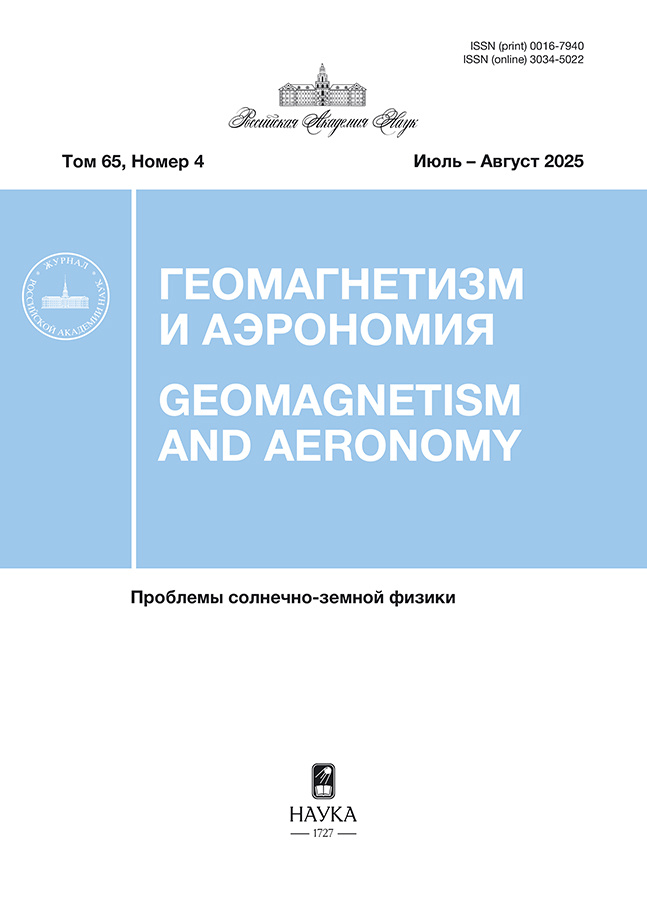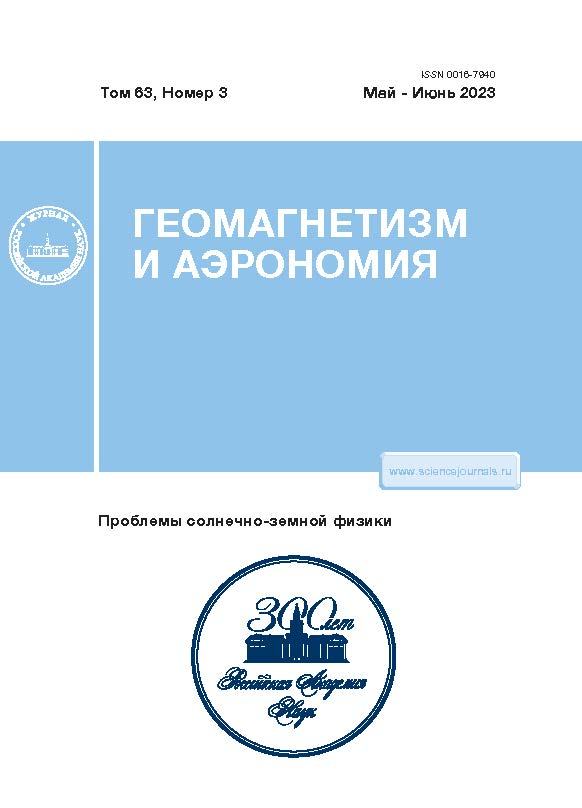Том 63, № 3 (2023)
Статьи
Крупномасштабные возмущения солнечного ветра по данным радиопросвечивания с космического аппарата MARS EXPRESS и локальных измерений на космическом аппарате WIND
Аннотация
Представлены результаты экспериментов радиопросвечивания околосолнечной плазмы сигналами спутника Марса Mars Express. В области гелиоцентрических расстояний прицельной точки лучевой линии 8–13 солнечных радиусов измерялись флуктуации частоты просвечивающих радиосигналов. В ходе проведения экспериментов как на восточном, так и на западном лимбах зафиксированы резкие усиления дисперсии флуктуаций частоты. В измерениях вблизи орбиты Земли на космическом аппарате Wind в смежные периоды с запаздыванием на 5–17 сут регистрировались увеличения концентрации протонов и напряженности магнитного поля, которые в 7–15 раз превышают фоновые значения. Сравнение между данными, относящимися к внутреннему и околоземному солнечному ветру, позволяет сделать вывод, что наблюдавшиеся возмущения связаны с одной и той же вращающейся с Солнцем областью солнечной короны.
 275-283
275-283


Влияние цикла Глейсберга на вариации периода 11-летнего цикла солнечной активности в 1700–2021 гг.
Аннотация
При помощи вейвлет-анализа проведено исследование спектрального состава числа солнечных пятен SN в течение 1700–2021 гг. Кроме доминирующей 11-летней составляющей, в спектре прослеживаются две мощные составляющие цикла Глейсберга: до 1880 г. ветвь с периодом ~60 лет, с 1850 г. ~115 лет. Найдено, что ряды длины и амплитуды солнечного цикла в целом находятся в обратной зависимости (коэффициент корреляции k = –0.5…–0.63). Лаг между рядами, при котором достигается максимум антикорреляции, зависит от времени. В XVIII–начале XIX века лаг равен одному циклу, в XIX в. – двум циклам, а начиная с 1950 г. и до нашего времени лаг уменьшается до 2 лет. Выделены квазипериодические структуры, которые характерны для длительных периодов пониженной солнечной активности. Такая спектральная особенность в ~1800 г. (минимум Дальтона) вызвана влиянием 60-летней ветви, а формирующаяся с начала XXI в. – более слабым влиянием околостолетней. Поэтому следует ожидать, что ближайшие солнечные циклы будут более высокими и менее длинными, чем в период минимума Дальтона. Показано, что вариации длины солнечного цикла за последние 321 год могут быть описаны в рамках модели, представляющей собой 11-летнее колебание, которое подвергается частотной модуляции ветвями цикла Глейсберга (60 и 115 лет) с изменяющимся во времени влиянием модулятора.
 284-297
284-297


Ветви резонансного ультранизкочастотного поглощения в магнитосфере Земли
Аннотация
Анализируются доплеровские наблюдения авроральной электроструи норвежским радаром STARE в течение одного солнечного оборота, предшествовавшего сильной магнитной буре. При этом наименьшая частота резонансного ультранизкочастотного поглощения определяется как частота ступенчатого падения спектральной плотности мощности наблюдаемого сигнала. В свою очередь, ч-астота ступенчатого падения спектральной плотности мощности определяется посредством решения минимальной вариационной задачи, которая наилучшим образом (метод наименьших квадратов) вписывает ступенчатую модель средней спектральной мощности в профиль спектральной плотности мощности реальных наблюдений. Последовательное сжатие спектрального окна, в котором решается вариационная задача, позволяет построить диаграммы решений минимальной задачи на плоскости частота – мощность резонансного поглощения. С помощью таких диаграмм выделены высокочастотная и низкочастотная ветви резонансного ультранизкочастотного поглощения. Обнаружено, что в слабовозмущенных условиях изменчивость резонансного ультранизкочастотного поглощения обусловлена, в первую очередь, вариациями мощности поглощения в обеих ветвях.
 298-305
298-305


Выделение солнечно-суточной анизотропии космических лучей локальным и глобальным методами
Аннотация
По данным нейтронного монитора ст. Москва с помощью гармонического анализа получены характеристики солнечно-суточной анизотропии космических лучей в спокойные дни за длительный период с 1965 по 2020 гг. Установлено, что средний суточный ход вариаций космических лучей нейтронных мониторов ст. Москва практически полностью описывается двумя гармониками солнечно-суточной анизотропии и не содержит признаков других влияний. Сравнение со среднесуточными характеристиками экваториальной составляющей векторной анизотропии космических лучей, полученными по данным мировой сети нейтронных мониторов с помощью метода глобальной съемки, показало хорошее согласие результатов двух методик. Из сравнения локальных и глобальных результатов получены оценки приемных коэффициентов первой гармоники анизотропии космических лучей для нейтронного монитора ст. Москва и предложен новый экспериментальный метод расчета приемных коэффициентов отдельных детекторов. Обсуждены и обоснованы ограничения локальной методики, а также возможности продолжения и расширения данного исследования.
 306-320
306-320


Прогнозирование изолированных суббурь пакетом параллельных нейросетей
Аннотация
Выполнен нейросетевой прогноз суббурь, обусловленных воздействием потоков плазмы солнечного ветра на магнитосферу Земли. Для этого были созданы рекуррентные нейросетевые модели, основанные на физических причинно-следственных связях динамики высокоширотной геомагнитной активности (по индексу AL) с параметрами межпланетного магнитного поля (ММП) и плазмы солнечного ветра (ПСВ). В качестве входных последовательностей использованы два параметра – Bz-компонента ММП и интегральный параметр Σ[NV 2], учитывающий предысторию процесса накачки кинетической энергии солнечного ветра в магнитосферу, где N и V – концентрация плазмы и скорость солнечного ветра, соответственно. Выполнен полноценный прогноз AL-индекса по данным ПСВ и ММП на 10 мин и т.д. с 10 мин дискретностью по отдельности индивидуальной искусственной нейронной сетью (ИНС) на каждую точку, отвечающую динамике AL-индекса. Это означает, что прогноз непрерывного ряда значений AL-индекса достигается параллельно работающим пакетом ИНС. Количество ИНС в пакете определяется скважностью необходимого прогнозируемого ряда AL-индекса, при этом учет 90 мин предыстории входных параметров в каждой из сетей обеспечивает прогноз значений AL-индекса с точностью до ~80%.
 321-326
321-326


Особенности полярных суббурь: анализ отдельных событий
Аннотация
К полярным суббурям относятся суббури, наблюдаемые на геомагнитных широтах выше 70° MLAT при отсутствии одновременных отрицательных магнитных бухт на более низких широтах, т.е. суббури на сжатом авроральном овале. На примере отдельных событий, зарегистрированных на арх. Шпицберген, рассмотрены общие морфологические особенности полярных суббурь. Показано, что полярные суббури, как и “классические” суббури, характеризуются формированием токового клина суббури, скачкообразным перемещением к полюсу после начала суббури; генерацией геомагнитных пульсаций Pi2, возрастанием РС-индекса полярной шапки перед началом суббури. В то же время имеются определенные отличия полярных суббурь от “классических” суббурь, а именно, начало на более удаленных L-оболочках, развитие в области сжатого аврорального овала, появления в более ранние предполуночные часы, генерация только при низкой скорости солнечного ветра и в слабо возмущенных геомагнитных условиях. Высказано предположение, что полярные суббури, по-видимому, представляют собой специфический тип “классических” суббурь, развивающихся в вечернем секторе при магнито-спокойных или слабо возмущенных условиях, когда авроральный овал сжат. Источником полярных суббурь может быть также локальная интенсификация существующих ранее суббурь в послеполуночном секторе.
 327-339
327-339


Возмущения в магнитосфере и ионосфере в отсутствие пятен на Солнце
Аннотация
Выполнен анализ геомагнитной и ионосферной активности за 541 возмущенный день (Kp > 3.0) без пятен на Солнце с 1995 по 2021 гг. Представлены оценки вариаций глобальных ионосферных индексов WU (положительные возмущения полного электронного содержания), WL (отрицательные возмущения), их разности WE и планетарного индекса Wp. Исходный W-индекс принимает значения от –4 до +4 с шагом 1, характеризующие меру отклонения текущего значения полного электронного содержания от спокойной медианы, а глобальные индексы WU, WL, WE, Wp выведены на основе глобальных карт GIM-TEC Лаборатории реактивного движения, JPL. Исследование сезонной зависимости показало два уровня ионосферной возмущенности: менее возмущенная ионосфера в течение 1996‒1998 гг. и 2018‒2021 гг. и более значительные возмущения в течение 2004‒2010 гг. и 2016‒2017 гг. Для ионосферной изменчивости сезонные вариации различаются для двух рядов данных. В первом наборе данных впервые выявлены сезонные вариации скорости солнечного ветра Vsw на околоземной орбите с максимумами в равноденствие, аналогичные вариациям Kp-индекса. Второй ряд более возмущенной ионосферы относится ко времени перехода от эпохи высокой СА к более низкой СА, характеризующейся полной перестройкой физических условий на Солнце.
 340-348
340-348


Эффективность относительного δ-параметра Барбье при поиске ионосферных предвестников землетрясений
Аннотация
Проведено исследование временны́х вариаций комплексного относительного δ-параметра Барбье (δBarbier) для оценки его эффективности при поиске ионосферных предвестников землетрясений. С этой целью было рассмотрено его поведение (по данным пятнадцатиминутных измерений ионосферных параметров) перед двумя сильными землетрясениями, для которых ионосферные предвестники землетрясений ранее уже были обнаружены. Первое землетрясение (с магнитудой M = 6.3) произошло 06.04.2009 г. (г. Л’Аквила, Италия) на эпицентральном расстоянии ~93 км от наземной станции вертикального зондирования ионосферы Рим, а второе (с магнитудой M = 7.2) случилось 30.01.2016 г., при этом его эпицентр оказался в ~117 км от наземной станции вертикального зондирования ионосферы, расположенной на территории комплексной геофизической обсерватории Паратунка, Камчатка. В обоих случаях в поведении параметра δBarbier были выделены специфические особенности, совпадающие по времени с ранее обнаруженными ионосферными предвестниками этих землетрясений. Это позволяет сделать вывод об успешной верификации эффективности использования параметра δBarbier при поиске ионосферных предвестников землетрясений.
 349-357
349-357


Береговой эффект в горизонтальных компонентах электрического поля
Аннотация
Приведены результаты экспериментальных исследований возмущений электрического поля, созданных источниками ионосферного происхождения в прибрежных зонах Белого и Баренцева морей. Регистрация данных выполнялась геофизическими станциями GI-MTS-1. Горизонтальное электрическое поле регистрировалось теллурическими линиями длиной ~50 м. Компонента Ех устанавливалась ортогонально береговой линии в направлении от берега, компонента Еу направлена вдоль береговой линии. В прибрежной зоне в полосе контакта море–суша выявлена примыкающая к кромке воды зона аномального увеличения амплитуды УНЧ-вариаций (F < 1 Гц) Ех-компоненты напряженности электрического поля. На расстоянии ~30 м от кромки воды наблюдается дополнительная узкая зона аномального усиления величины УНЧ-вариаций электрического поля. Максимальный береговой эффект наблюдается возле кромки воды в береговой зоне и уменьшается с удалением от берега моря.
 358-365
358-365


Уточненная пространственно-временнáя модель поля ускорений главного магнитного поля на поверхности Земли и геомагнитные джерки
Аннотация
Построены уточненные пространственные сферические гармонические модели кусочно-постоянного поля вековых ускорений главного магнитного поля Земли, исходя из концепции о геомагнитных джерках. Проанализированы данные 189-и магнитных обсерваторий, оперирующих в течение расширенного периода исследований, полагая, что джерки являются признаками резких изменений магнитогидродинамических режимов квази-стационарного процесса генерации вековых вариаций магнитного поля в области спектра высоких частот. Проведен качественный и количественный анализ, показывающий устойчивость моделей настоящей генерации, их согласованность с исходными значениями ускорений, полученных из данных прямых обсерваторских наблюдений. По расширенному временнóму интервалу исследований уточнено время появления джерков, выявлено, что в масштабе всей Земли они имеют квази-десятилетнюю частоту повторяемости, через которую можно оценить временнýю протяженность отдельных режимов стационарного эволюционирования глобального магнитного поля ядра Земли. Анализом результатов сферического гармонического моделирования по картам глобального поля постоянных ускорений доказана внутриземная природа источников всех выявленных джерков, а также особенности их морфологических структур и степень распространенности на поверхности Земли.
 366-390
366-390


Тепловой режим литосферы под полуостровом Таймыр по геомагнитным данным
Аннотация
В статье представлены результаты исследования теплового режима литосферы под полуостровом Таймыр и сопредельными территориями (70°–80° N, 80°–115° E) по геомагнитным данным. Спектральный анализ аномального геомагнитного поля, заданного моделью EMAG2v3, выполнен с помощью метода центроида. Проведенные расчеты показали, что минимальные значения глубины верхней границы литосферных магнитных источников (<2.5 км) характерны для всего Таймырского складчатого пояса и рассматриваемой части Сибирской платформы, максимальные (>6 км) – для Северо-Карского бассейна. Положение верхней границы магнитоактивного слоя литосферы выше подошвы осадочного слоя под Енисей-Хатангским и Хатангско-Ленским бассейнами может быть связано с повсеместным внедрением в осадочный слой базальтовых траппов. Минимальные значения глубины нижней границы литосферных магнитных источников (<36 км) приурочены к Евразийскому бассейну и соседними с ним территориями шельфа моря Лаптевых и островов архипелага Северная Земля, что свидетельствует о наибольшем в пределах рассматриваемого региона прогреве литосферы под ними. Максимальных значений (≥48 км) глубина нижней границы достигает под Енисей-Хатангским, Северо-Карским бассейнами и Сибирской платформой, указывая на существование здесь холодной и, соответственно, мощной литосферы, что подтверждается другими независимыми геофизическими данными.
 391-402
391-402


ДИСКУССИИ
Оценка средних значений чисел Вольфа циклов минимума Дальтона по характеристикам достоверных циклов ряда
Аннотация
Исходным материалом для ряда чисел Вольфа служат как архивные записи разрозненных наблюдений, так и регулярные наблюдения в обсерваториях. Многие исследователи опираются на ряд чисел Вольфа, включающий восстановленные данные архивных записей, хотя свойства и характеристики восстановленной и достоверной частей ряда существенно отличаются. Также противоречивы параметры и самой восстановленной части. Естественно, что согласование свойств восстановленного и достоверного рядов сгладит противоречия и расширит массив более надежных показаний. C учетом связи между характеристиками достоверных циклов представлены варианты групповой коррекции средних значений циклов I–IX. Так как при сопоставлении протяженных фрагментов локальные невязки данных играют меньшую роль, то опираясь на интегральные оценки этих фрагментов (без детализации условий их формирования), мы получили более взвешенные интервальные оценки. Параметры интервалов (групп циклов) достоверного ряда служат основой коррекции.
 403-408
403-408













